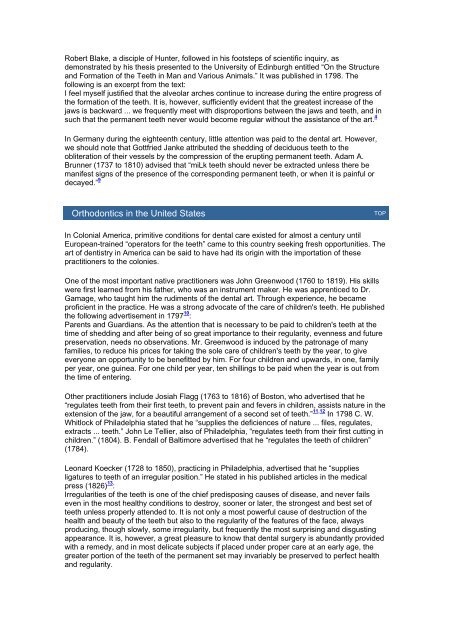A brief history of orthodontics - ortodontia e ortopedia facial
A brief history of orthodontics - ortodontia e ortopedia facial
A brief history of orthodontics - ortodontia e ortopedia facial
Create successful ePaper yourself
Turn your PDF publications into a flip-book with our unique Google optimized e-Paper software.
Robert Blake, a disciple <strong>of</strong> Hunter, followed in his footsteps <strong>of</strong> scientific inquiry, as<br />
demonstrated by his thesis presented to the University <strong>of</strong> Edinburgh entitled “On the Structure<br />
and Formation <strong>of</strong> the Teeth in Man and Various Animals.” It was published in 1798. The<br />
following is an excerpt from the text:<br />
I feel myself justified that the alveolar arches continue to increase during the entire progress <strong>of</strong><br />
the formation <strong>of</strong> the teeth. It is, however, sufficiently evident that the greatest increase <strong>of</strong> the<br />
jaws is backward ... we frequently meet with disproportions between the jaws and teeth, and in<br />
such that the permanent teeth never would become regular without the assistance <strong>of</strong> the art. 4<br />
In Germany during the eighteenth century, little attention was paid to the dental art. However,<br />
we should note that Gottfried Janke attributed the shedding <strong>of</strong> deciduous teeth to the<br />
obliteration <strong>of</strong> their vessels by the compression <strong>of</strong> the erupting permanent teeth. Adam A.<br />
Brunner (1737 to 1810) advised that “miLk teeth should never be extracted unless there be<br />
manifest signs <strong>of</strong> the presence <strong>of</strong> the corresponding permanent teeth, or when it is painful or<br />
decayed.” 9<br />
Orthodontics in the United States TOP<br />
In Colonial America, primitive conditions for dental care existed for almost a century until<br />
European-trained “operators for the teeth” came to this country seeking fresh opportunities. The<br />
art <strong>of</strong> dentistry in America can be said to have had its origin with the importation <strong>of</strong> these<br />
practitioners to the colonies.<br />
One <strong>of</strong> the most important native practitioners was John Greenwood (1760 to 1819). His skills<br />
were first learned from his father, who was an instrument maker. He was apprenticed to Dr.<br />
Gamage, who taught him the rudiments <strong>of</strong> the dental art. Through experience, he became<br />
pr<strong>of</strong>icient in the practice. He was a strong advocate <strong>of</strong> the care <strong>of</strong> children's teeth. He published<br />
the following advertisement in 1797 10 :<br />
Parents and Guardians. As the attention that is necessary to be paid to children's teeth at the<br />
time <strong>of</strong> shedding and after being <strong>of</strong> so great importance to their regularity, evenness and future<br />
preservation, needs no observations. Mr. Greenwood is induced by the patronage <strong>of</strong> many<br />
families, to reduce his prices for taking the sole care <strong>of</strong> children's teeth by the year, to give<br />
everyone an opportunity to be benefitted by him. For four children and upwards, in one, family<br />
per year, one guinea. For one child per year, ten shillings to be paid when the year is out from<br />
the time <strong>of</strong> entering.<br />
Other practitioners include Josiah Flagg (1763 to 1816) <strong>of</strong> Boston, who advertised that he<br />
“regulates teeth from their first teeth, to prevent pain and fevers in children, assists nature in the<br />
extension <strong>of</strong> the jaw, for a beautiful arrangement <strong>of</strong> a second set <strong>of</strong> teeth.” 11,12 In 1798 C. W.<br />
Whitlock <strong>of</strong> Philadelphia stated that he “supplies the deficiences <strong>of</strong> nature ... files, regulates,<br />
extracts ... teeth.” John Le Tellier, also <strong>of</strong> Philadelphia, “regulates teeth from their first cutting in<br />
children.” (1804). B. Fendall <strong>of</strong> Baltimore advertised that he “regulates the teeth <strong>of</strong> children”<br />
(1784).<br />
Leonard Koecker (1728 to 1850), practicing in Philadelphia, advertised that he “supplies<br />
ligatures to teeth <strong>of</strong> an irregular position.” He stated in his published articles in the medical<br />
press (1826) 13 :<br />
Irregularities <strong>of</strong> the teeth is one <strong>of</strong> the chief predisposing causes <strong>of</strong> disease, and never fails<br />
even in the most healthy conditions to destroy, sooner or later, the strongest and best set <strong>of</strong><br />
teeth unless properly attended to. It is not only a most powerful cause <strong>of</strong> destruction <strong>of</strong> the<br />
health and beauty <strong>of</strong> the teeth but also to the regularity <strong>of</strong> the features <strong>of</strong> the face, always<br />
producing, though slowly, some irregularity, but frequently the most surprising and disgusting<br />
appearance. It is, however, a great pleasure to know that dental surgery is abundantly provided<br />
with a remedy, and in most delicate subjects if placed under proper care at an early age, the<br />
greater portion <strong>of</strong> the teeth <strong>of</strong> the permanent set may invariably be preserved to perfect health<br />
and regularity.


